
Collies form a distinctive type of herding dogs, including many related landraces and standardized breeds. The type originated in Scotland and Northern England. Collies are medium-sized, fairly lightly-built dogs, with pointed snouts. Many types have a distinctive white color over the shoulders. Collies are very active and agile, and most types of collies have a very strong herding instinct. Collie breeds have spread through many parts of the world, and have diversified into many varieties, sometimes mixed with other dog types. Some collie breeds have remained as working dogs for herding cattle, sheep, and other livestock, while others are kept as pets, show dogs or for dog sports, in which they display great agility, stamina and trainability. While the American Kennel Club has a breed they call "collie", in fact collie dogs are a distinctive type of herding dog inclusive of many related landraces and formal breeds. There are usually major distinctions between show dogs and those bred for herding trials or dog sports: the latter typically display great agility, stamina and trainability, and, more importantly, sagacity.

A landrace is a domesticated, locally adapted, traditional variety of a species of animal or plant that has developed over time, through adaptation to its natural and cultural environment of agriculture and pastoralism, and due to isolation from other populations of the species. Landraces are generally distinguished from cultivars, and from breeds in the standardized sense, although the term landrace breed is sometimes used as distinguished from the term standardized breed when referring to cattle.

The Border Leicester is a British breed of sheep. It is a polled, long-wool sheep and is considered a dual-purpose breed as it is reared both for meat and for wool. The sheep are large but docile. They have been exported to other sheep-producing regions, including Australia and the United States.

The Danish Landrace is a medium to large breed of pig, white in colour with long bodies, fine hair, long snouts, and heavy drooping ears. They are bred for pork production. There are two distinct varieties, the white and the piebald

The Tamworth, also known as Sandy Back and Tam, is a breed of domestic pig originating in its namesake Tamworth, Staffordshire United Kingdom. It is among the oldest of pig breeds, but as with many older breeds of livestock, it is not well suited to modern production methods and is listed as "threatened" in the United States and "vulnerable" in the UK by the Rare Breeds Survival Trust, as fewer than 300 registered breeding females remain. This animal is of ginger to red colouration and is thought to have descended from wild boars, via native pig stock of Europe. Principal populations today are in the United Kingdom, Australia, the United States, New Zealand, and Canada.
The American Landrace is a medium to large breed of domestic pig, white in color, with long bodies, fine hair, long snouts, and heavy, drooping ears. They are bred for pork production

The Berkshire is a British breed of pig. It originated in the English county of Berkshire, for which it is named. It is normally black, with some white on the snout, on the lower legs, and on the tip of the tail.

The Wessex Saddleback or Wessex Pig is a breed of domestic pig originating in the West Country of England, (Wessex), especially in Wiltshire and the New Forest area of Hampshire. It is black, with white forequarters. In Britain it was amalgamated with the Essex pig to form the British Saddleback, and it is extinct as a separate breed in Britain. However, the Wessex Saddleback survives in Australia and New Zealand.
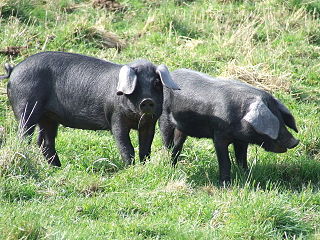
The Large Black pig is a British breed of domestic pig. It is the only British pig that is entirely black. It was created in the last years of the nineteenth century by merging the black pig populations of Devon and Cornwall in the south-west with those of Essex, Suffolk and Kent in the south-east. It is hardy, docile and prolific; it forages well and is suitable for extensive farming, but not well suited to intensive management.
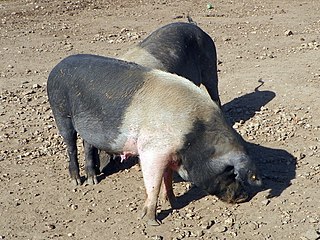
The British Saddleback is a modern British breed of domestic pig. It was created in 1967 by merging the surviving populations of two traditional saddleback breeds, the Essex and Wessex Saddleback.
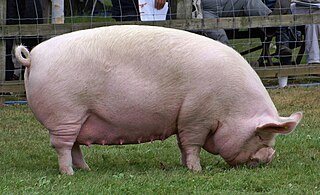
The Middle White is a British breed of domestic pig. It originated in Yorkshire, and derived from the Large White and the now-extinct Small White. It was recognised in 1852, and the first herd-book was published in 1884. It is a porker, reared for fresh pork, and is characterised by a short and sharply-upturned snout. After the Second World War it came close to extinction; although numbers have recovered somewhat, it is listed by the Rare Breeds Survival Trust as "priority" – the highest level of risk.

The British Lop is an old pig breed native to the United Kingdom. A large, white pig, it is named for its large ears which hang over its face. The breed was originally developed as an amalgamation of several local lop-eared breeds in England, and came to be known as the British Lop in the 1960s.

The Welsh is a breed of domestic pig native to Wales. It is a large white breed known for its hardiness in outdoor (extensive) farming, its long, pear-shaped body and its lop-ears. The breed was first mentioned in the 1870s, and after the Howitt committee report in 1955, became the third most common sire in the United Kingdom after the Large White pig and British Landrace pig. The Welsh pig experienced a decline in numbers in the late twentieth century because consumer demands had changed and the carcase was considered too fatty. In 2005 the breed was considered endangered and later came under the auspices of the Rare Breeds Survival Trust. Since then numbers have expanded somewhat, and by 2012, the registered breeding herd had increased to over 1000 animals.

The Italian Landrace is an Italian breed of domestic pig. It derives from the Danish Landrace breed developed in Denmark at the end of the nineteenth century. Stock was imported into Italy after the Second World War. The breed has been selected principally for suitability for the production of prosciutto crudo. It is, after the Large White Italiana, the second-most numerous pig breed in Italy. The breed standard is issued by the Ministero delle Politiche Agricole Alimentari e Forestali, the Italian ministry of agriculture and forestry; the herdbook is kept by the Associazione Nazionale Allevatori Suini, the national pig-breeders' association.
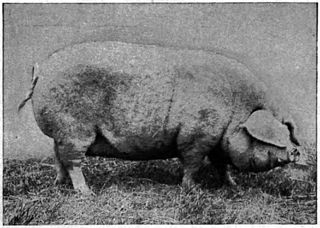
The Lincolnshire Curly Coat or Lincolnshire Curly-coated, also known as the Baston Pig, is an extinct British breed of domestic pig. It originated in, and was named for, the county of Lincolnshire, in the East Midlands. Like many other traditional pig breeds, it became rare after the Second World War. By 1970, it had disappeared. An older, still existing breed of similar looking pigs is the Hungarian Mangalica.

The British Landrace is a British domestic breed of pig and one of the most popular in the United Kingdom. It is white with heavy drooping ears that cover most of the face and is bred for pork and bacon. The breed originated in the 1949 importation of 12 landrace pigs from Scandinavia — four boars and eight gilts. In 1950, the British Landrace Pig Society was formed and it opened a herd book for the first offspring born from the imported 12. They created the first pig testing scheme with a testing station at the village of Stockton-on-the-Forest in North Yorkshire.
The Lacombe is a breed of domestic pig native to Canada. Named for the Lacombe Research and Development Centre in Lacombe, Alberta, the breed was the first strain of livestock developed in the country.
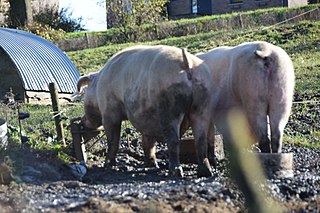
The Belgian Landrace, also known as the Improved Belgian, Belgian Improved Landrace, and the Belgian Lop-eared, is a breed of domestic pig from northern Belgium. It was created from importing English breeds and improving them until they were "graded up" to the German Improved Landrace from 1930 to 1945 and then breeding them with the Dutch Landrace in 1945. Other breeds were also incorporated into the bloodline to strengthen it, such as with ones from Luxembourg in 1955, Germany in 1971, and the Czech Republic in 1974. Used in many different countries, the Belgian Landrace is also one of the "four major commercial breeds" in France.
The Dutch Landrace pig is a standardized breed of domestic pig originating in the Netherlands. The breed was developed from the native landrace of pigs of the area, crossbred with strains from neighboring counties. The Dutch Landrace is considered "a meaty and efficient breed". The breed is unusually responsive to the halothane test, which can be used to weed out individuals with low projected survivability and meat production.
The Large White Ulster, or Ulster White, was a breed of domestic pig. Primarily bred for bacon production, it was the favoured breed of farmers in the north of Ireland up until the mid 20th century.
















